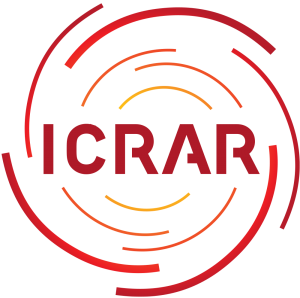
 DATES
DATES
October 1-5, 2018
LOCATION
Geraldton Multipurpose Centre, Geraldton, Western Australia (map)
DESCRIPTION
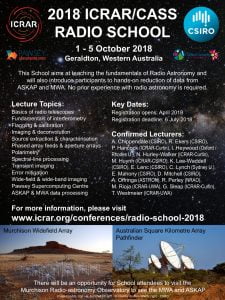
Official poster (PDF file).
Radio astronomy has entered an exciting phase with the advent of new radio telescopes in Australia and around the world. These telescopes have vastly improved scientific performance in a number of key areas, including sensitivity, image fidelity, transient detectability, frequency range, field of view, and ability to deal with atmospheric and ionospheric effects. Moreover, the new Australian radio telescopes (ASKAP and MWA) are located at a supremely radio-quiet site, which further enhances scientific capability.
However, data from the ASKAP phased array feeds and the MWA aperture array require new algorithms for calibration, flagging, wide field-of-view imaging, and image distortion, and typically require semi-automated pipelines running on supercomputers in order to deal with the vast quantities of data.
This School aims at teaching the fundamentals of Radio Astronomy to participants and postdoctoral scientists at the Ph.D level or above. It will also introduce participants to hands-on reduction of data from ASKAP and MWA, and introduce the Pawsey supercomputer centre, part of which is dedicated to radio astronomy analysis. No prior experience with radio astronomy is required.
With the advent of science operations on ASKAP and MWA phase 2, the School also aims to facilitate more cross-use of the two facilities, facilitate scientific and technical synergies, and to expose participants to tools and techniques likely to be useful for analysis of data from the future Square Kilometre Array.
The School will be held in the beautiful coastal city of Geraldton, which is strategically located between the Murchison Radio-astronomy Observatory and Perth, and which provides a home base for most of the permanent MRO staff. There will be an opportunity for School attendees and lecturers to visit the Murchison Radio-astronomy Observatory to see ASKAP, MWA and SKA verification systems.
The School is jointly hosted by the International Centre for Radio Astronomy Research and CSIRO Astronomy and Space Science, with the generous support of the Pawsey Supercomputing Centre and the Geraldton City Council.
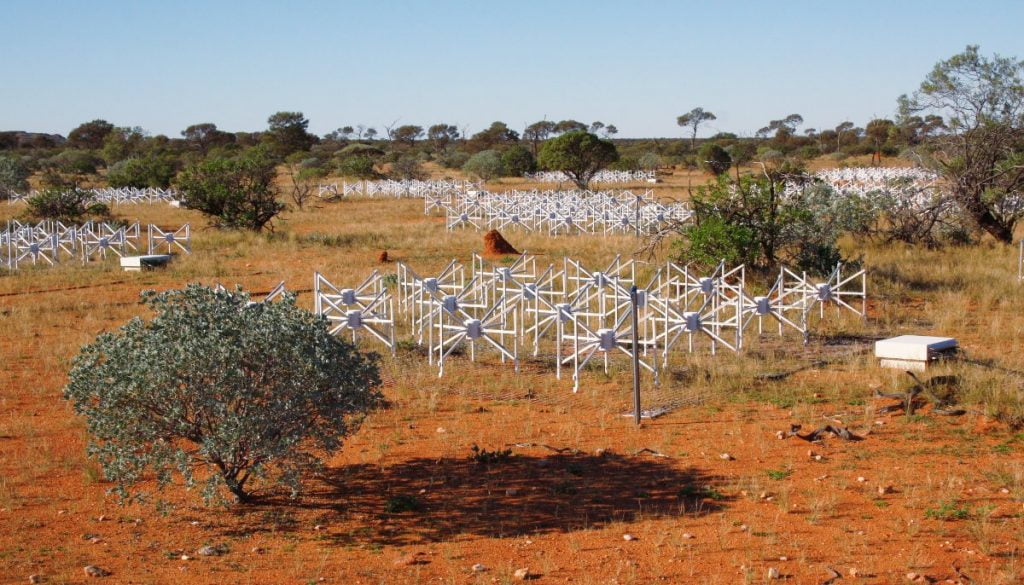
The Murchison Widefield Array. (Credit: Tobias Westmeier)
TOPICS
- Basics of radio telescopes
- Fundamentals of interferometry
- Flagging and calibration
- Imaging and deconvolution
- Source extraction and characterisation
- Phased array feeds and aperture arrays
- Polarimetry
- Spectral-line processing
- Transient imaging
- Error mitigation
- Wide-field and wide-band imaging
- Pawsey Supercomputing Centre
- Practical ASKAP and MWA data processing
KEY DATES
- First Announcement: 1 May 2018.
- Registration opens: April 2018
- Registration Deadline: 6 July 2018
- School starts: 1 Oct 2018
CONFIRMED LECTURERS
- Aaron Chippendale (CSIRO)
- Ron Ekers (CSIRO)
- Paul Hancock (ICRAR–Curtin)
- Ian Heywood (U. Oxford / Rhodes U.)
- Natasha Hurley-Walker (ICRAR–Curtin)
- Minh Huynh (ICRAR / CSIRO)
- Karen Lee-Waddell (CSIRO)
- Emil Lenc (CSIRO)
- Christene Lynch (ICRAR–Curtin)
- Elizabeth Mahony (CSIRO)
- Daniel Mitchell (CSIRO)
- André Offringa (ASTRON)
- Rick Perley (NRAO)
- María Rioja (ICRAR–UWA)
- Tim Shimwell (Sterrewacht Leiden)
- Greg Sleap (ICRAR–Curtin)
- Daniel Ung (ICRAR–Curtin)
- Tobias Westmeier (ICRAR–UWA)
VENUE
Lectures and tutorials will be held at the Geraldton Multipurpose Centre which is located on the Geraldton Foreshore overlooking the stunning Indian Ocean. Location on Google Maps: https://goo.gl/maps/nVjhc6oawMr.
PROGRAMME
The programme will commence at 9 AM on Monday, October 1 and conclude by 4:30 PM on Friday, October 5.
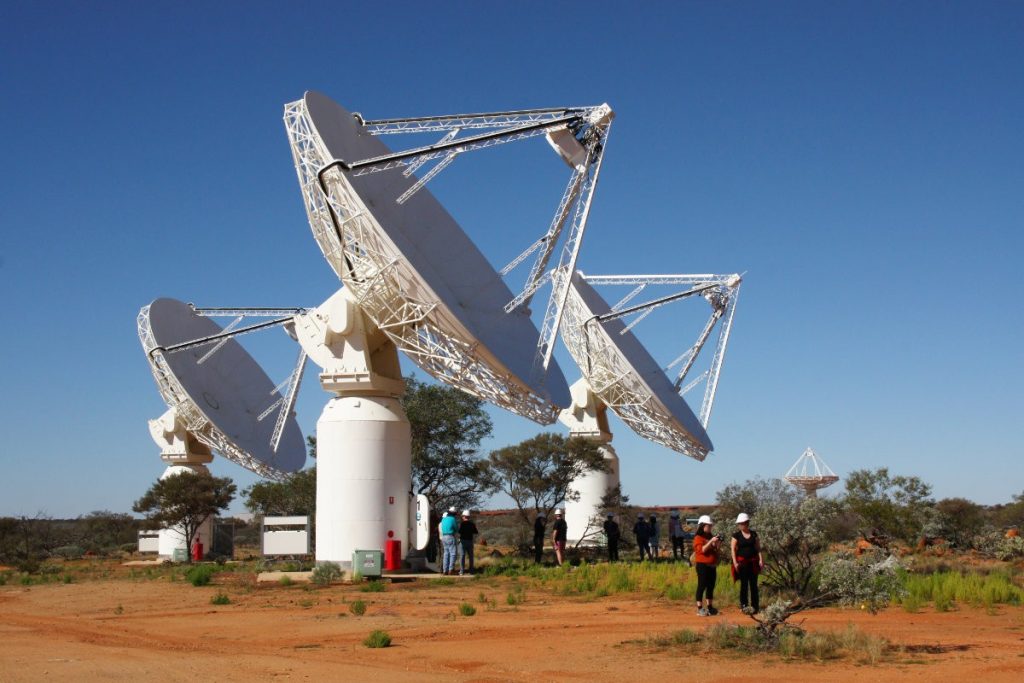
The core of the Australian SKA Pathfinder. (Credit: Tobias Westmeier)
ARRIVAL, DEPARTURE AND TRANSFERS
Unless arriving early or leaving late for personal reasons, attendees are recommended to arrive from Perth via Qantas or Virgin flights by Sunday evening Sept 30 or Monday morning Oct 1, and depart for Perth on Friday evening Oct 5 or Sat morning Oct 6. Early booking is recommended. Some airport and hotel transfers will be arranged – otherwise use the local taxi services.
No bus transfers will be provided from Perth to Geraldton or vice versa. Hotel recommendations for an overnight stay in Perth can be provided on request.
An alternative way of travelling from Perth to Geraldton would be to rent a car at Perth Airport for the entire week and drive to Geraldton along the scenic Indian Ocean Drive. The distance from Perth to Geraldton is about 400 km which would take about 4.5 hours by car (excluding stops). The spectacular Pinnacles are located about halfway in between Perth and Geraldton and would be a great place to stop and explore for a couple of hours along the way.
HOTELS
A number of hotels, including the following, are available within walking distance of the venue. Once your application has been accepted, please choose and arrange your own accommodation well in advance (walking distance and indicative cost per night given):
- Ocean Centre Hotel (0.5 km, 3 star, $190)
- Mantra Geraldton (1.1 km, 4 star, $260)
- The Gerald – Apartment Hotel (0.6 km, 4 star, $230)
- Sails Geraldton (1.6 km, 3 star, $120)
- Best Western Hospitality Inn Geraldton (2 km, 3 star, $160)
Scam Alert!
Some participants have been approached by a company called EHS, attempting to pressure them into booking a room through their website. Please do not respond to any e-mails or phone calls from anyone claiming to organise accommodation for the 2018 Radio School, as these are likely to be fraudulent with the aim of obtaining the credit card details of the victim. We will arrange block bookings for hotels in Geraldton and send out instructions to all participants and lecturers on how to book your own hotel room at a later stage.
If you have any queries, please email us.
MRO VISIT
A day visit to the Murchison Radio-astronomy Observatory will occur on Thursday, October 4. Return bus transport from the hotels to the MRO will be provided. Beware that the bus journey may take over 4 hours each way (including rest breaks). The MRO visit is subject to weather and road conditions.
A moderate amount of walking on unsealed paths will be required. The weather may be warm – the mean maximum temperature in October is 30°C – so please bring a hat, sunscreen, a long-sleeved shirt, closed shoes, and water. Mobile phones must be switched off. There will be no mobile coverage for most of the journey.
A light sandwich lunch will be provided at the MRO.
OTHER ACTIVITIES
A welcome reception will be held on Monday evening, October 1. The workshop dinner will occur on Tuesday evening, October 2. The details are to be confirmed and will be announced at a later stage.
REGISTRATION
The registration cost will be AUD 300. Participants and lecturers are required to apply for registration. The registration cost is waived for lecturers. Numbers will be restricted, so your application for registration does not guarantee attendance. Priority will be given to astronomy PhD students and postdoctoral researchers. You will be notified of acceptance or otherwise of your application to register in July.
Costs for the School are already heavily subsidised, but a small number of applications for financial support will be considered on a case-by-case basis.
SCIENTIFIC ORGANISING COMMITTEE
- Lachlan Campbell (Pawsey Centre)
- Paul Hancock (ICRAR/Curtin, co-chair)
- George Heald (CASS)
- Karen Lee-Waddell (CASS, co-chair)
- James Miller-Jones (ICRAR/Curtin)
- Lister Staveley-Smith (ICRAR/UWA)
- Tobias Westmeier (ICRAR/UWA, co-chair)
LOCAL ORGANISING COMMITTEE
- Angela Dunleavy (ICRAR–Curtin)
- Tracey O’Keefe (ICRAR–UWA, chair)
- Beth Cloake (CASS, Perth)
- Rochelle Desmond (CASS, Geraldton)
SPONSORS
The School is jointly run by the International Centre for Radio Astronomy Research (ICRAR) and CSIRO Astronomy and Space Science, with the generous support of the Pawsey Supercomputing Centre and Geraldton City Council.


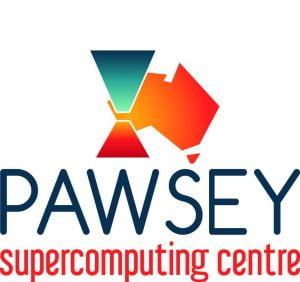

CODE OF CONDUCT